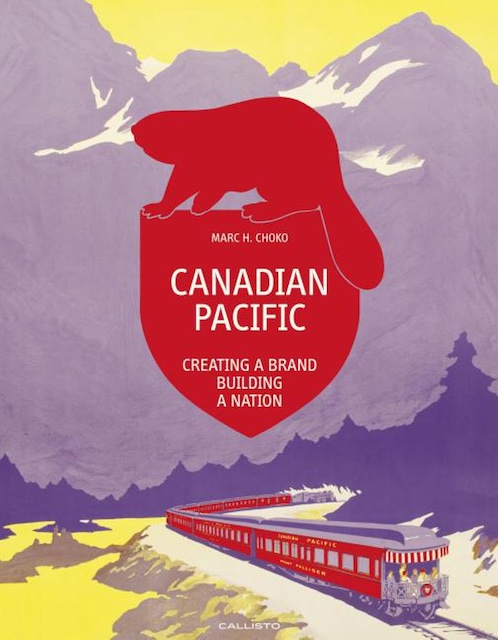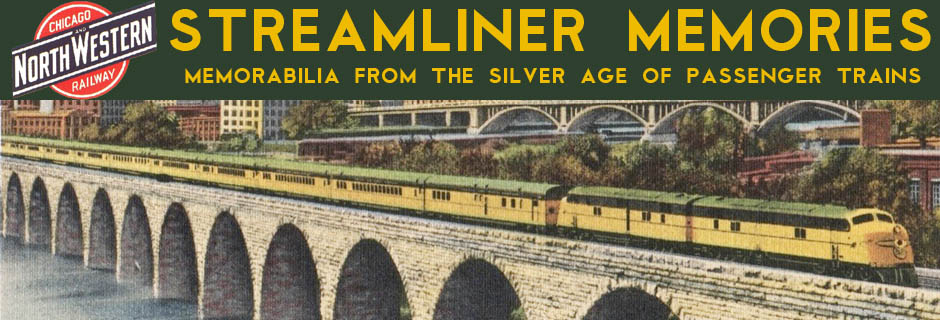Since I began Streamliner Memories in 2012, I’ve posted more than 5,000 documents relating to passenger train history. I’ve now posted almost everything in my own collection and I can’t help but wonder: what should I do now? For example, could I turn this web site into a book? I’m hoping you can help answer this question.

I started to think about this when I learned that Marc Choko, who co-authored two books on Canadian Pacific posters that I frequently use as references, has also written a much larger book: Canadian Pacific: Creating a Brand, Building a Nation. A publisher named Callisto released this 384-page book in three increasingly sumptuous editions, all of which are available from various book dealers. The standard edition, shown above, is 9″x12″, weighs 4 pounds, and originally sold for $70.
The premium edition is 12″x16″, has a few more graphics, weighs a massive 12 pounds, and originally cost $175. The collector’s edition consisted of the premium edition in a box with a wood veneer cover, and originally sold for $900. That’s one expensive box!
With some effort, I could turn Streamliner Memories into a book like this. Such a book would be more accessible than the web site for many people because it would be better organized and it would be possible to see everything in one place without having to look at dozens of web pages. Since my collection is predominately oriented to the West, the book would focus on the seven western U.S. railroads that crossed the Rockies to the Pacific (AT&SF, CMStP&P, D&RGW-WP, GN, NP, SP, and UP) with a secondary look at five midwestern railroads that connected some of those seven with the rest of the country (C&NW, CB&Q, CRI&P, MP, and Wabash).
The book would present the covers of many of the booklets on the web site, show most of the inside pages of some of the booklets (such as name-train booklets), and show nearly all of the menus I’ve found for the seven western railroads as well as posters, postcards, and other items. These images would be accompanied by text ranging from the history of steam locomotion to the technologies required for streamlined trains to biographies of some of the artists who illustrated many railroad advertisements. Stories of Great Northern’s historical expeditions, railway leaders such as Ralph Budd, and similar topics that might not be found in any other book would also be covered.
I’ve written a detailed outline dividing the book into four parts: the construction era (roughly 1860-1895), the Golden Age of passenger trains (1896-1933), the streamliner era (1934-1970), and the Amtrak era (1971-present). The two middle chapters would fill most of the book while the first and last would be relatively brief.
I’m inquiring with various publishers but also exploring the idea of self-publishing the book. I’ve self-published books before, but never one as big and expensive as this one. If I self-publish this one, I need to have some assurance that people will want to buy it.
Based on the printing quotes I have received so far, I think I can make a 9×12 book that would sell for $75 to $95 and/or a 12×16 book that would sell for $125 to $150. There may be some hidden costs I haven’t yet accounted for, but my goal would be to make the book as affordable as possible.
For a few extra dollars, I could also add a bonus feature consisting of a thumb drive with the entire Streamliner Memories web site as of the end of 2023. This would save people the effort of downloading all 34 gigabytes of documents that have been posted so far.
Many of the railroad photo books being published today are 8-1/2″x11″. The Choko poster book that I own is 9″x12″. The 12″x16″ premium edition of the Canadian Pacific book is extremely impressive as a coffee table book but is also pretty unwieldy for casual reading. I’m leaning towards a 9×12 book but may also print some 12x16s if it looks like there is a demand for a book that big.
So, my question for you is: would you be interested in a book like this? Or would you think that, since it merely duplicates much of what is on the Streamliner Memories web site, that you would not need to add it to your bookshelf? If you would be interested, would you have a preference regarding size and do you think the thumb-drive bonus would be worthwhile? Please answer even if your answer is “no.” I appreciate your thoughts and ideas.

Yes. Emphatically yes. I think the 9-by-12 would likely be most practical for the reasons you cite–lower cost, easier to hold. And I suspect the thumb drive is one of those ideas that sounds great, but in the end doesn’t get used all that much. But whatever you decide, publish it!
This would be a fantastic book. You have an excellent collection of railroad paper, and you have the facts and research to detail their significance and evolution. I’d buy a copy!
I would spend many hours enjoying such a book. Your eye for detail, and your impressive knowledge of the minutiae of history, makes it sure to be a good read. I appreciate your wry asides and observations about somewhat questionable claims or omissions made by marketing departments, or the choices made in photos, artwork and layouts. I do hope that you’ll be working on this.
I’m not entirely sure what else you can put into a book that can’t be had here. And taking things down to print the book doesn’t feel fair.
Also, you have a tendency to get a bit political/biased at times. You are generally good about it, but there is definitely a few cases where a distinctly “Right-Wing” or “Libertarian” attitude creeps in. Since people from all across the political spectrum can enjoy trains, it probably grates on the nerves of those who regarded themselves as being more “Left-Wing” or “Liberal” (in the modern sense).
This is much less of an issue on a website where people aren’t paying unless they wish to make a donation (which I don’t even think that you have as an option), but it gets more tricky when asking for what some people might regard as a considerable investment.
I’m sure that there are many people who enjoy this website but don’t necessarily have the means to afford a book-maybe they are putting themselves through college or they are children (I know that I, at least, was reading Lucius Beebe’s books by age 9), or they just don’t have access to money or whatever. A young man in Kenya or Nigeria might be able to justify a smart phone as a business expense and then surf the internet to discover this site in their spare time, but I really can’t see them buying a book.
For that matter, a book becomes even more difficult for people who attend this website from around the world. You can use Google Translate to at least get a good idea of what a particular post is about, but translation systems for written (on paper) documents are not as reliable yet, and are much more cumbersome to use.
I personally can fit the cost into my budget. But I feel that it is important to include all of the people who might come here to learn and enjoy. As much as we like to think of books as freeing knowledge and being liberating, it is a sad truth that the need to print them creates a price barrier that not all people can cross.
00Zy99,
I have no intention of taking this web site down. The book would simply be another medium. I am running out of things to post, so I may take another break this fall during which I’ll work on the book.
Why not a digital version for those of us on a budget?
Another minor issue is there already is a book called Streamliner memories so thrd be some confusion on the market.
https://www.amazon.com/Streamliner-Memories-Enthusiast-Color-Schafer/dp/0760306192
Aaron Moser,
Since less than half of my planned book would be about the streamliner era, it won’t be called Streamliner Memories. It will focus on the railroads that connected the Midwest with the Pacific Coast, so I was thinking of calling it something like Rails to the Pacific or Across the Continental Divide. Your suggestions would be appreciated.
As for a digital version, I might do that but it would be included on the thumb drive, if there is one, and not sold separately.